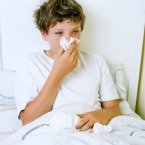Influenza...
Flu (Influenza)

Almost
every child has influenza from time to time. Commonly called the flu,
the high fever and muscle aches caused by influenza are hard to ignore,
often forcing the most active youngster into bed for a few days of rest
and recovery.
Influenza is a respiratory illness caused by a virus. Flu infections are highly contagious. They spread easily in schools, households, child care settings, the workplace, and any other places where groups of people are together. Your child can catch the flu if someone around her has the infection and sneezes or coughs, sending viral droplets into the air where they can be breathed in by others. She can also get the disease by touching a toy that has been contaminated by someone with the infection and then putting her hand or fingers into her mouth or nose. Children are most contagious during the 24 hours before symptoms begin and the period when their symptoms are at their worst.
Although there are 3 influenza viruses—types A, B, and C—most flu outbreaks are caused by A or B. Epidemics of influenza usually occur during the winter months, often lasting through March.
Particularly in infants, influenza can cause ear infections, croup, bronchiolitis (an infection of the lungs’ small breathing tubes), or pneumonia.
To help make your feverish youngster more comfortable and reduce her temperature, some pediatricians recommend giving her acetaminophen (although there’s evidence that a fever is the body’s way of fighting off the invading infection). However, do not give aspirin to any child or teenager who has a temperature. The use of aspirin in such circumstances has been associated with a rare but very serious illness called Reye syndrome. Be sure to read the labels on any medicine you plan to give to your child because some medicines contain aspirin (acetylsalicylic acid) as part of their ingredients!
These are some of the common signs of complications associated with the flu, such as an ear infection, a sinus infection, or pneumonia. Complications are more likely to occur in a child who has an underlying health problem, including heart disease, lung disease, a weakened immune system, or a malignancy.
 *salam*
*salam*
Influenza is a respiratory illness caused by a virus. Flu infections are highly contagious. They spread easily in schools, households, child care settings, the workplace, and any other places where groups of people are together. Your child can catch the flu if someone around her has the infection and sneezes or coughs, sending viral droplets into the air where they can be breathed in by others. She can also get the disease by touching a toy that has been contaminated by someone with the infection and then putting her hand or fingers into her mouth or nose. Children are most contagious during the 24 hours before symptoms begin and the period when their symptoms are at their worst.
Although there are 3 influenza viruses—types A, B, and C—most flu outbreaks are caused by A or B. Epidemics of influenza usually occur during the winter months, often lasting through March.
Signs and Symptoms
When your child gets the flu, she will probably develop a fever (temperature greater than 100°F), usually quite rapidly, often accompanied by the chills, headaches, lack of energy, a dry cough, and muscle aches and pain. As the illness progresses, other symptoms such as a sore throat and runny or stuffy nose may develop and worsen. Some children also have abdominal pain, nausea, and vomiting.Particularly in infants, influenza can cause ear infections, croup, bronchiolitis (an infection of the lungs’ small breathing tubes), or pneumonia.
What You Can Do
You’re probably familiar with many of the home treatments for the flu. They’ve been used by generations of parents, although they are not as useful in getting rid of the virus as some parents think. Your child may benefit from getting plenty of rest, and she should drink liquids to prevent dehydration.To help make your feverish youngster more comfortable and reduce her temperature, some pediatricians recommend giving her acetaminophen (although there’s evidence that a fever is the body’s way of fighting off the invading infection). However, do not give aspirin to any child or teenager who has a temperature. The use of aspirin in such circumstances has been associated with a rare but very serious illness called Reye syndrome. Be sure to read the labels on any medicine you plan to give to your child because some medicines contain aspirin (acetylsalicylic acid) as part of their ingredients!
When to Call Your Pediatrician
Contact your pediatrician early if your child has flu symptoms—some antiviral medicines work best if given within the first 48 hours after symptoms begin. In particular, let your doctor know if a fever continues, your child complains of an earache, or she has a cough that does not go away.These are some of the common signs of complications associated with the flu, such as an ear infection, a sinus infection, or pneumonia. Complications are more likely to occur in a child who has an underlying health problem, including heart disease, lung disease, a weakened immune system, or a malignancy.
Comments
Post a Comment